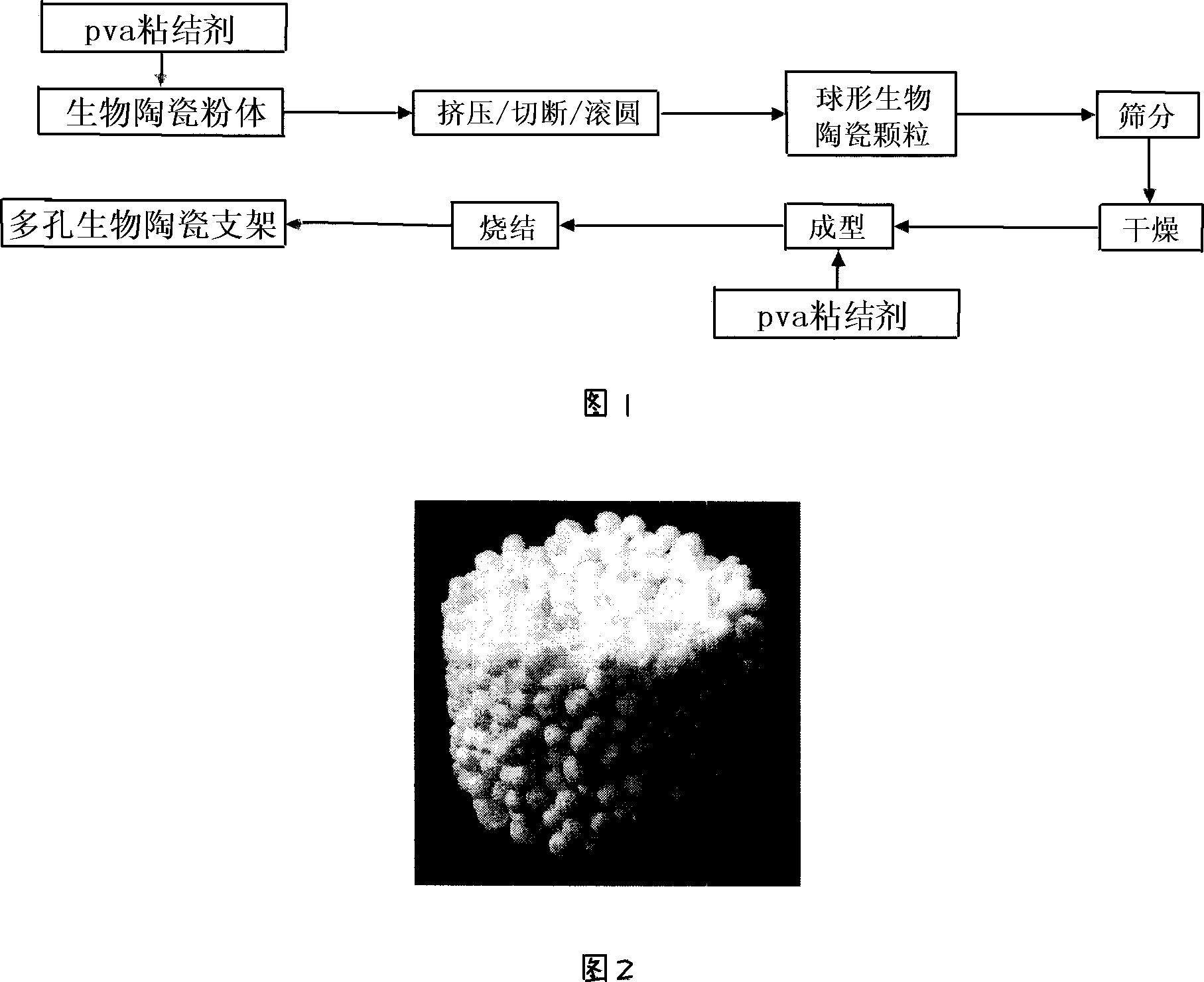Process for preparing porous biological ceramics supporting frame
A technology of bioceramics and pore diameter, which is applied in medical science, prosthesis, etc., can solve the problems of residue preparation process, complexity, and large connection diameter of porous bioceramic scaffolds, and achieve high sphericity, small equipment volume, The effect of high powder utilization rate
- Summary
- Abstract
- Description
- Claims
- Application Information
AI Technical Summary
Problems solved by technology
Method used
Image
Examples
Embodiment 1
[0028] Example 1: Preparation of a porous bioceramic scaffold with a diameter larger than 100 μm.
[0029] This porous bioceramic scaffold can ensure that osteoclasts with a diameter of 100 μm pass through each pore. Referring to Table 1, select a sieve with 24-26 meshes to screen out the spherical particle structure scaffold with a diameter of 710-800 μm, and the pore diameter of the scaffold is between 110-586 μm. The specific process is as follows:
[0030] Weigh 30g of PVA aqueous solution with a mass concentration of 5% as a binder, mix it with 70g of tricalcium phosphate bioceramic powder, and use the Mini-250 extrusion spheronizer produced by Shenzhen Xinyite Pharmaceutical Equipment Co., Ltd. The ceramic powder is subjected to orifice plate extrusion, cutting and spheronizing processes to produce tricalcium phosphate spherical particles, and the tricalcium phosphate spherical particles with a diameter of 710-800 μm are screened out with a 24-26 mesh sieve and dried fo...
Embodiment 2
[0033] Example 2: Preparation of a porous bioceramic scaffold with a diameter less than 400 μm.
[0034] This porous bioceramic scaffold has high mechanical properties and osseointegration performance. Studies have shown that when the pore size is greater than 400 μm, the bonding force of bone decreases. Referring to Table 1, select a 35-40 mesh sieve to screen out a spherical particle structure scaffold with a diameter of 450-500 μm, and the pore size of the scaffold is between 70-366 μm. The specific process is as follows:
[0035]Weigh 20g of PVA aqueous solution with a mass concentration of 3% as a binder, mix it with 80g of calcium-deficient hydroxyapatite bioceramic powder, and use the Mini-250 extrusion spheronization produced by Shenzhen Xinyite Pharmaceutical Equipment Co., Ltd. The granulator implements orifice plate extrusion, cutting and spheronizing process on the ceramic powder to produce calcium-deficient hydroxyapatite particles, and uses a 35-40 mesh sieve t...
Embodiment 3
[0039] Example 3: Preparation of a porous bioceramic scaffold with a pore diameter of less than 800 μm.
[0040] This porous bioceramic scaffold has better blood circulation ability, which is beneficial to realize bone repair in parts far away from the heart where blood circulation is weak. Although this porous bioceramic scaffold is not optimal in terms of bone bonding at the initial stage of implantation in the human body, as the osteoblasts grow on the scaffold, the pore diameter gradually becomes smaller, and the bone bonding will increase. be strengthened. Referring to Table 1, select a 18-20 mesh sieve to screen out the particle structure scaffolds with a diameter of 900-1000 μm, and a pore size of 139-732 μm. The specific process is as follows:
[0041] Weigh 50g of PVA aqueous solution with a mass concentration of 4% as a binder, mix it with 50g of alumina bioceramic powder evenly, and use the Mini-250 extrusion spheronizer produced by Shenzhen Xinyite Pharmaceutical...
PUM
| Property | Measurement | Unit |
|---|---|---|
| Diameter | aaaaa | aaaaa |
| Diameter | aaaaa | aaaaa |
| Diameter | aaaaa | aaaaa |
Abstract
Description
Claims
Application Information
 Login to View More
Login to View More - R&D
- Intellectual Property
- Life Sciences
- Materials
- Tech Scout
- Unparalleled Data Quality
- Higher Quality Content
- 60% Fewer Hallucinations
Browse by: Latest US Patents, China's latest patents, Technical Efficacy Thesaurus, Application Domain, Technology Topic, Popular Technical Reports.
© 2025 PatSnap. All rights reserved.Legal|Privacy policy|Modern Slavery Act Transparency Statement|Sitemap|About US| Contact US: help@patsnap.com

